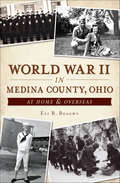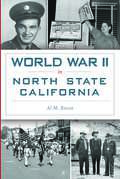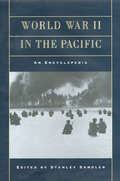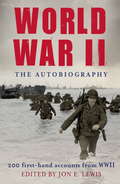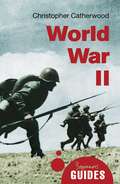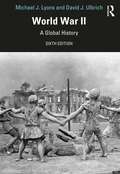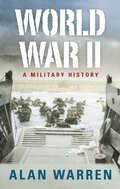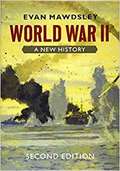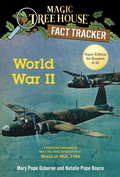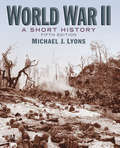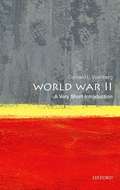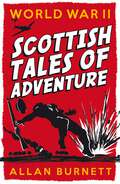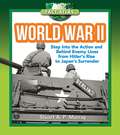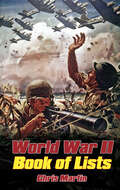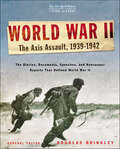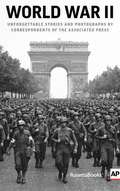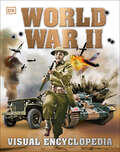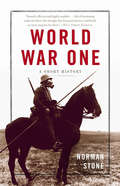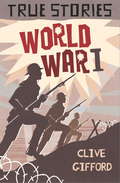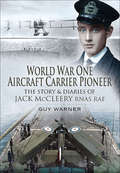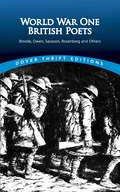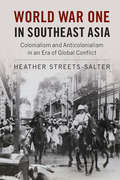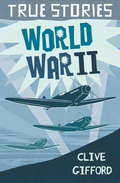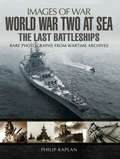- Table View
- List View
World War II in Medina County, Ohio: At Home & Overseas (Military)
by Eli R. BeachyFor the first time in the lives of many Medina County residents, places across the world became real, not just dots on a map. With the outbreak of World War II, men and women who had never left their corner of Ohio were encircling the globe. They were at Pearl Harbor and the Canal, Anzio and the Bulge. They built atomic bombs and bought millions in war bonds. Discover not one great hero but an entire generation of heroism. Eli R. Beachy traces the sublime story of one small community in a great, united effort--those most remarkable people of Medina County, Ohio.
World War II in North State California (Military)
by Al M. RoccaOn Sunday morning, December 7, 1941 the world changed for the North State—and the nation. A national call to arms by President Franklin D. Roosevelt after the bombing of Pearl Harbor spurred local residents to action, and the normal rhythm of life immediately and dramatically changed. By Christmas of that year, everyone understood their roles. Those who could enlist served in Army and Navy operations in the Pacific and Europe. The rest gave their all to support the war from the home front. Residents volunteered their time and skills, served as Red Cross workers, airplane spotters and scrap metal collectors. Local factories and canneries ramped up production. And building the Shasta Dam to provide power became a crucial part of the war effort. Author Al M. Rocca recounts the determination and tribulations of North State citizens during World War II.
World War II in the Pacific: An Encyclopedia (Military History of the United States)
by Sandler StanleyStanley Sandler, one of America's most respected and best-known military historians, has brought together over 300 entries by some 200 specialists in the field to create the first encyclopedia specifically devoted to the Pacific Theatre of World War II.Extending far beyond battles and hardware, the coverage ranges from high policy-making, grand strategy, and the significant persons and battles of the conflict, to the organization of the Allied and Japanese divisions, aircraft, armor, artillery, psychological warfare, warships, and the home fronts, covering the interactions of each topic along the way.
World War II: 200 First-Hand Accounts from WWII
by Jon E. LewisA remarkable series of over 200 eye-witness accounts taken from diaries, letters, speeches, interviews and memoirs of those who were there: pilots, sailors, generals, infantrymen, war correspondents and leaders. These include Spitfire pilot Richard Hillary's account of bailing out of his plane in the Battle of Britain; a German sailor's view of HMS Royal Oak being torpedoed at Scapa Flow; insights into Rommel's ailing health from a lieutenant in the Afrika Korps; famous war correspondent Ernie Pyle's account of GI meals during Operation Torch; Anne Frank's recollection of the rounding up of Jews in Amsterdam; the last letters home from anonymous German soldiers in Stalingrad; the view from a Japanese cockpit over Pearl Harbor on 7 December 1941; a German officer's memories of the airborne assault on Crete in May 1941; the firestorm following the bombing of Dresden in July 1943 in the words of a German woman; a lieutenant in the 1st Airborne Divsion's eyewitness account of the fighting in Arnhem; Martha Gellhorn on the aftermath of the Battle of the Bulge; a British tank officer crossing the German border on 28 February 1945; on the Kokoda Trail in New Guinea; an Allied intelligence officer being executed by the Japanese; the tunnels of Iwo Jima; and a kamikaze pilot's final letter.
World War II: A Beginner's Guide (Beginner's Guides)
by Christopher CatherwoodWith over sixty million casualties, World War II was the bloodiest conflict in history. In this incisive introduction, esteemed academic Christopher Catherwood covers all the key battles and campaigns, while also giving the larger story behind them, putting familiar events into the perspective of the war at large. He explores the huge impact of the preceding Sino-Japanese War on World War II itself; the relative unimportance of the British conflict in Africa; the near moral-equivalence of the Red Army and the Nazis; and the impact of the Hiroshima bombing. Full of text-boxes revealing key details about British intelligence, weaponry, and the social milieu to the conflict, there is no better brief introduction to this landmark event.
World War II: A Global History
by David J. Ulbrich Michael J. LyonsFully revised and restructured, the sixth edition of World War II: A Global History offers students a concise and yet thorough textbook that examines history’s bloodiest conflict. The chapters alternate between chronological chapters on Europe and Asia-Pacific and thematic chapters on innovations, home fronts, brutal regimes, and logistics. This textbook includes the following features: A lively narrative of facts, events, people, and ideas that incorporates thoughtful analysis New material and restructured content on global factors that affected the causes, conduct, and consequences of World War II Balanced pace that does not bog readers down in too many details yet gives them sufficient depth and breadth for context Chapters, sections, and sidebars arranged in ways that can complement lectures and assignments Fifty new photographs that illustrate the human condition and weaponry during World War II. Global in focus, by blending both geographic and thematic chapters to ensure readers gain a comprehensive understanding of impact of the war worldwide, this is the perfect volume for all students of the biggest global conflict of the twentieth century.
World War II: A Military History
by Alan WarrenIn the First World War many battles on the Western Front had lasted weeks or months. All too often they degenerated into glacial and indecisive campaigns of attrition. By the 1930s, however, military science had recreated the possibility of a decisive battle. An unprecedented rate of technological change meant that a stream of new inventions were readily at hand for military innovators to exploit. Aircraft, armoured vehicles and new forms of motorised transport became available to make possible a fresh style of offensive warfare when the next European war began in 1939. A belief in the importance of effective war fighting was vital to the Nazi vision of Germany's future. Nazi Germany's political and military leaders aimed for rapid and decisive victory in battle. From 1939-45 new ideologies and new machines of war carried destruction across the globe. Alan Warren chronicles the sixteen most decisive battles of the Second World War, from the Blitzkrieg of Poland to the fall of Berlin.
World War II: A New History
by Evan MawdsleyThis is a revised and updated edition of Evan Mawdsley's acclaimed global history of World War II. Beginning with the outbreak of the Sino-Japanese War, Evan Mawdsley shows how the war's origins lay in a conflict between the old international order and the new and traces its globalisation as it swept through Asia, Europe and the Middle East. <P><P>The primary focus is on the war's military and strategic history, though also examines the political, economic, ideological and cultural factors which influenced the course of events. The war's consequences are examined too, not only in terms of the defeat of the Axis but also of the break-up of colonial empires and the beginning of the Cold War. Accessibly written and well-illustrated with maps and photographs, the book also includes insightful short studies of the figures, events and battles that shaped the war, as well as fully updated guides to further reading.
World War II: A Nonfiction Companion to Magic Tree House Super Edition #1: World at War, 1944 (Magic Tree House (R) Fact Tracker #36)
by Mary Pope Osborne Natalie Pope Boyce Carlo MolinariIn the next Magic Tree House® Fact Tracker, track the facts about World War II—with Jack and Annie! When Jack and Annie came back from their adventure in Magic Tree House Super Edition #1: World at War, 1944, they had lots of questions. How did World War II begin? Why were so many innocent people killed? What was D-Day? Find out the answers to these questions and more as Jack and Annie learn all about one of the darkest hours of history. Filled with up-to-date information, photographs, illustrations, and tidbits from Jack and Annie, the Magic Tree House Fact Trackers are the perfect way for kids to find out more about the topics they discover in their favorite Magic Tree House adventures. And teachers can use the Fact Trackers alongside their Magic Tree House fiction companions to meet Common Core text pairing needs. Have more fun with Jack and Annie on the Magic Tree House website at MagicTreeHouse.com! Did you know there’s a Magic Tree House book for every reader? Find the perfect book for you: Classic: Adventures with Jack and Annie, perfect for readers who are just starting to read chapter books. F&P Level M. Merlin Missions: More challenging adventures for the experienced Magic Tree House® reader. F&P Level N. Super Edition: A longer and more dangerous adventure with Jack and Annie. F&P Level P. Fact Trackers: Non-fiction companions to your favorite Magic Tree House® adventures
World War II: A Short History
by Michael J. LyonsHighly regarded for its concise clarification of the complexities of World War II, this book illuminates the origins, course, and long-range effects of the war. It provides a balanced account that analyzes both the European and Pacific theaters of operations and the connections between them. The Fifth Edition incorporates new material based on the latest scholarship, offering updated conclusions on key topics and expanded coverage throughout.
World War II: A Very Short Introduction (Very Short Introductions Series)
by Gerhard L. WeinbergThe enormous loss of life and physical destruction caused by the First World War led people to hope that there would never be another such catastrophe. How then did it come to be that there was a Second World War causing twiceas much loss of life and more destruction than any other previous conflict? In this Very Short Introduction, Gerhard L. Weinberg provides an introduction to the origins, course, and impact of the war on those who fought and the ordinary citizens who lived through it. Starting by looking at the inter-war years and the German invasion of Poland in September 1939, he examines how the war progressed by examining a number of key events, including the war in the West in 1940, Barbarossa, the German Invasion of the Soviet Union, the expansion of Japan's war with China, developments on the home front, and the Allied victory from 1944-45. Exploring the costs and effects of the war, Weinberg concludes by considering the long-lasting mark World War II has left on society today.
World War II: Scottish Tales Of Adventure
by Allan BurnettThe Second World War from a Scottish point of view—stories about men and women, allies and enemies to captivate and intrigue young readers. Acclaimed children&’s author Allan Burnett turns his attention to the Second World War in a book of explosively exciting and emotionally charged tales of bravery and adventure. Featuring the true exploits of soldiers, spies, pilots, sailors and many others, these stories, all based on interviews with these heroes themselves or their descendants, offer a unique, personal insight into the Second World War that no conventional history book can ever hope to match. &“With accounts of life on a variety of fronts this is a valuable introduction to life during the Second World War for younger readers . . . In a slim volume he manages to pack a lot in, allowing the reader a taste of a wide range of views and experiences, and never succumbing to a simplistic goodies versus baddies take on things . . . the heart of the stories themselves is surely universal, reminding us that war is a multi-faceted business affecting different people in all sorts of different ways.&” —Daily Record
World War II: Step into the Action and behind Enemy Lines from Hitler's Rise to Japan's Surrender (Fact Atlas Series #No. 6)
by Stuart MurrayThe Fact Atlas series offers an age-appropriate overview of the historic and world-changing events of World War II, covering everything from the rise of Hitler and Nazism to the tragedy of the Holocaust and its long-lasting effects. Readers will be introduced to key players--political and military leaders like Winston Churchill and Franklin Roosevelt as well as Joseph Stalin, Benito Mussolini, and many more. Explore the ideas of democracy versus totalitarianism and international relations as a whole during the 1930s. Learn more about the different countries that became involved in the Second World War, with a focus on most of Europe, the United States, and Japan. Lesser-known facts about the involvement of countries such as China, Libya, Ethiopia, and New Zealand make it very clear that the war touched all corners of our world. Accompanied by photos and maps to outline specific events, this book offers a careful breakdown of how the war played out globally. Battles and campaigns are explained and examined, and young readers will be able to follow the war from beginning to end, analyzing causes and effects of each important event. World War II gives young readers the opportunity to grasp the weight and magnitude of one of the very worst wars the world has seen.
World War II: The Autobiography
by Jon E. LewisHow will the Second World War be remembered? Not as a series of strategic battles but as a dramatic turning point in world history, recorded through the personal accounts, diaries, and speeches of those that were there. World War Two: the Autobiography places centre stage the individual accounts of over 200 people who saw events unfolding before their eyes: from the first stirrings of Nazi aggression, to the phoney war and the Blitzkrieg; from the frozen wastes of the Eastern Front to life under the threat of the Blitz in London. This autobiography offers a panoramic view of the conflict and with entries from all the major figures of the war, including Churchill, Field Marshal Montgomery, Hitler, Stalin and Rommel, as well as accounts from the men and women on the front line, the home front and those unfortunate to be prisoners of war, from all sides of the conflict.
World War II: The Book of Lists
by Chris MartinEverything you ever wanted to know about the Second World War, from the highest-rated fighter aces to the most inventive escape equipment used to break out of Colditz; from army pay by rank to the largest battleships; from the most stirring speeches to the biggest tactical errors; from the strangest regimental mottoes to the plays most performed by ENSA; and from the dates each country joined the war to the most unlikely spies. All the major events and dates in the war are covered in detail, but equal emphasis is placed on the human experience of combat. Often poignant and always revealing, World War II: the Book of Lists offers a unique insight into the deadliest conflict in human history.
World War II: The Diaries, Documents, Speeches, and Newspaper Reports That Defined World War II (The New York Times Living History)
by Douglas BrinkleyIntroducing a new series where history comes alive in riveting documents and images of great events as they occurred.We have long relied on historians to sift through the debris of history and piece together narratives to shape our understanding of events. But it is in the letters, diaries, speeches, song lyrics, newspaper articles, and government papers that history comes alive. The New York Times Living History books reinvigorate history by presenting the actual documents and images of the day. For the volume World War II: The Axis Assault, 1939-1942 eminent historian Douglas Brinkley has carefully chosen fifty critical documents that chart the Axis's grip over Europe and the Pacific--such as Churchill's Blood and Toil speech and the text of the Atlantic Charter. Readers will find FDR's cables to Japan in the hours before Pearl Harbor, Edward R. Murrow's broadcast during the Blitz, an American G.I.'s last message from Corregidor, and a Dutch boy's diary recounting Germany's invasion.Each primary document is accompanied by New York Times reporting or commentary from the period and original text illuminating their historical significance. News photos and other images add a strong visual component to this vivid re-creation of history.
World War II: Unforgettable Stories and Photos by Correspondents of The Associated Press
by The Associated PressPowerful, visceral, and essential to preserving and understanding our past, the work of Associated Press photographers and journalists lives on through the pages of World War II.Never before in history had the day-to-day struggles and victories of war—from the home front to the front lines—been chronicled in such graphic and unflagging detail as during the Second World War. Nearly 200 photographers and reporters of Associated Press volunteered to cover the war across the globe from 1939 through 1945. The heroic achievements of these reporters and photographers—some of whom gave their lives—are remembered through the stunning photographs and moving firsthand reports of World War II: Unforgettable Stories and Photographs by Correspondents of The Associated Press.World War II commemorates the experiences of the individuals who brought the war into the homes of millions of Americans. Originally published in 1945 as Reporting to Remember: Unforgettable Stories and Pictures of the War by Associated Press Correspondents, this updated anniversary edition includes a new interview with former AP World War II correspondent George Bria, as well as a new Foreword by current AP Vice President for International News John Daniszewski.
World War II: Visual Encyclopedia (DK Children's Visual Encyclopedias)
by DKThis comprehensive visual encyclopedia explores World War II in fascinating detail and explains why this global event must never be forgotten. World War II: Visual Encyclopedia shows children the causes, battles, people, and aftermath, while cutting-edge CGI technology brings infamous events back to life. Learn about weaponry, tanks, ships, aircraft, campaigns, and military strategies. Read firsthand accounts of major campaigns and battles throughout the war. Uncover hundreds of biographies of wartime leaders and brave soldiers who served on the battlefields. Find out how technological advances influenced the final outcome. Key information is available at a glance, alongside data boxes, facts and stats, and inspiring quotations. From the fastest fighter plane to the longest battle, you&’ll discover everything you ever wanted to know, and much, much more.Whether you&’re a history buff or simply want help on a school project, this standout reference covers every aspect of World War II and the important part it has played in world history.
World War One $ A Short History: A Short History
by Norman StoneThe First World War was the overwhelming disaster from which everything else in the twentieth century stemmed. Fourteen million combatants died, four empires were destroyed, and even the victors’ empires were fatally damaged. World War I took humanity from the nineteenth century forcibly into the twentieth-and then, at Versailles, cast Europe on the path to World War II as well. In World War One, Norman Stone, one of the world’s greatest historians, has achieved the almost impossible task of writing a terse and witty short history of the war. A captivating, brisk narrative, World War One is Stone’s masterful effort to make sense of one of the twentieth century’s pivotal conflicts.
World War One (True Stories #4)
by Clive GiffordThe book contains nine short stories dealing with different aspects of life during World War I.World War I includes the stories of flying aces such as the 'Red Baron', the story of Lawrence of Arabia and the stories of brave doctors and nurses such as Edith Cavell in German occupied Belgium.Complete with glossary, further reading section and index.
World War One Aircraft Carrier Pioneer: The Story and Diaries of Captain JM McCleery RNAS/RAF
by Guy WarnerJack McCleery was born in Belfast in 1898, the son of a mill owning family. He joined the RNAS in 1916 as a Probationary Flight Officer. During the next ten months he completed his training at Crystal Palace, Eastchurch, Cranwell, Frieston, Calshot and Isle of Grain, flying more than a dozen landplanes, seaplanes and flying boats, gaining his wings as a Flight Sub-Lieutenant. In July 1917 he was posted to the newly commissioning aircraft carrier HMS Furious, which would be based at Scapa Flow and Rosyth. He served in this ship until February 1919, flying Short 184 seaplanes and then Sopwith 1 Strutters off the deck. He also flew a large number of other types during this time from shore stations at Turnhouse, East Fortune and Donibristle.He served with important and well-known naval airmen including Dunning, Rutland (of Jutland) and Bell Davies VC. He witnessed Dunnings first successful landing on a carrier flying a Sopwith Pup in 1917 and his tragic death a few days later. He also witnessed the Tondern raid in 1918, the worlds first carrier strike mission. He took part in more than a dozen sweeps into the North Sea by elements of the Grand Fleet and Battle Cruiser Fleet. He carried out reconnaissance missions off the coast of Denmark, landing in the sea to be picked up by waiting destroyers. He witnessed the surrender of the High Seas Fleet. Promoted to Captain, he acted as temporary CO of F Squadron for a time postwar.
World War One British Poets: Brooke, Owen, Sassoon, Rosenberg and Others (Dover Thrift Editions: Poetry Ser.)
by Candace WardA complex series of treaties, tensions and alliances involving the major and minor European states led to the assassination of Archduke Franz Ferdinand of Austria by Gavrilo Princip, a Serbian nationalist, on June 28, 1914. In response, the armies of Europe were mobilized and by summer's end, the world was at war. But no one could have foreseen the apocolyptic degree of destruction that ensued. By the time the Armistice was signed on November 11,1918, more than nine million military personnel and five million civilians had been killed. In Great Britain and Europe, an entire generation of young men was wiped out. Most of the poets in this anthology participated in what came to be called the Great War; many of them did not survive to see its end. Some, like Rupert Brooke and John McCrae, believed their services were part of a noble and just cause. Others - most notably Siegfried Sassoon and Wilfred Owen - entered the military through a sense of duty, though both poets came to see Britain's participation in the war as unnecessarily prolonged. Antiwar sentiment was not uncommon among soldiers, particularly when it became clear that the war was one of attrition. By September 1914, the Allied and Central Powers were locked into trench warfare, and 1915-1916 were years of stalemate characterized by Pyrrhic victories such as that won by the Allies in Champagne, where 500 yards of ground was gained over the course of two months - at a cost of 50,000 men. Such results contributed to a sense of futility experienced by frontline soldiers, and chlorine gas, first deployed on the Western Front on April 22, 1915 at the Battle of Ypres, intensified the horrors of battle. The initial patriotic fervor that compelled many young men to enlist in the summer of 1914 had, in most cases, by 1916 collapsed into cynicism and anger, as reflected in a saying that circulated among the British troops: "Went to war with Rupert Brooke, came home with Siegfried Sassoon." While not all of the poets contained in this anthology served combat duty, all were touched by the devastation that changed the world's perception of war. Despite the propaganda and intense anti-German sentiment that proliferated during the war, "this was no case," as Edward Thomas wrote, "of petty right or wrong." All of the poetry - whether the manifestation of the poets' despair, outrage or patriotism -- stands as a memorial that has outlasted the battle lines of World War One.
World War One in Southeast Asia
by Heather Streets-SalterAlthough not a major player during the course of the First World War, Southeast Asia was in fact altered by the war in multiple and profound ways. Ranging across British Malaya, the Dutch East Indies, and French Indochina, Heather Streets-Salter reveals how the war shaped the region's political, economic, and social development both during 1914–18 and in the war's aftermath. She shows how the region's strategic location between North America and India made it a convenient way-station for expatriate Indian revolutionaries who hoped to smuggle arms and people into India and thus to overthrow British rule, whilst German consuls and agents entered into partnerships with both Indian and Vietnamese revolutionaries to undermine Allied authority and coordinate anti-British and anti-French operations. World War One in Southeast Asia offers an entirely new perspective on anti-colonialism and the Great War, and radically extends our understanding of the conflict as a truly global phenomenon.
World War Two (True Stories #1)
by Clive GiffordThe book contains nine short stories dealing with different aspects of life during World War II.Included is the remarkable survival story of future US President J F Kennedy, the story of the dambusters and a plotted assassination attempt on Hitler.Complete with glossary, further reading section and index.
World War Two at Sea: The Last Battleships
by Philip KaplanThis wide-ranging naval history features rare wartime battleship images combined with thrilling first person accounts from servicemen.During the Second World War, big-gun battleships represented the ultimate power of the world’s greatest navies. In this book, veteran battleship crew members describe their unforgettable experiences aboard these iconic vessels. Here are the vivid recollections of a Royal Navy officer at Jutland; tales of the loss of the German warship Scharnhorst in the arctic; combat experience inside a sixteen-inch gun turret aboard an Iowa-class battleship during the Gulf War; and many others.Included too is the story of the great German battleship Bismarck, which sank the pride of the British fleet; the story of HMS Hood; and that of the USS Missouri,on whose deck the final surrender document of the Second World War was signed.The text is combined with a compelling selection of historic images representing the era of the great battleships from the early years through the First and Second World Wars, Korea, Vietnam, the Gulf War, and the preservation of a handful of these vessels as museum pieces today.
